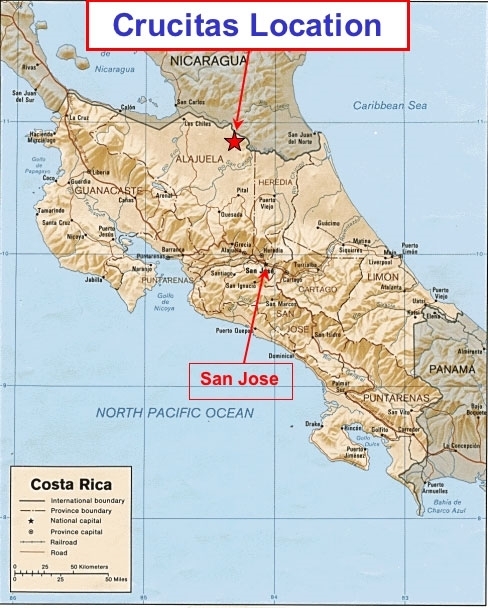By Martin Mowforth
At the beginning of March this year (2023), the government of Costa Rica declared a state of emergency in numerous districts in the north of the country due to the contamination of the drinking water supply with mercury used in the illegal extraction of gold in Crucitas. Two weeks earlier the Municipal Council of San Carlos had also declared an emergency in several northern border communities. The ban on water usage affects four aqueducts and all artisanal wells in the area. Since September (2022), the national Institute of Aqueducts and Sewers has provided potable water by tanks and trucks in the affected area.
Crucitas is located close to the border with Nicaragua and the Río San Juan which divides the two countries. At the start of this century, the Canadian company Infinito Gold created an open pit mine to extract the considerable gold reserves there. The company did so despite Costa Rica’s moratorium on open pit mining, although then President Oscar Arias controversially reversed the ban citing ‘national interest’ reasons for doing so.
In November last year (2022), samples of water for human consumption collected by the Ministry of Health showed levels of mercury above internationally accepted standards. The maximum admissible level of mercury in water is 0.001 milligrams per litre. In one school in Crucitas, a sample registered 0.053 mg/L. The regional director of the Ministry of Health, Luis Diego Ugalde Jiménez, described the situation as “very worrying. The water should not be consumed; nor should it be used for cooking or bathing. … We have a genuine environmental emergency here.” Mercury can severely affect the human nervous system.
After significant protests, in 2010 the Costa Rican courts overturned Infinito Gold’s permit on environmental grounds. Infinito Gold turned to the World Bank’s International Centre for the Settlement of Investment Disputes (ICSID) seeking $400 million in damages and lost profits. It took ten years for the ICSID to give a mixed judgement in 2021 which gave both parties to the dispute some gains but decided that the legal costs incurred in the case should be equally shared.
The other effect of the 2010 permit cancellation was the creation of a modern-day gold rush to the Crucitas area, especially after Infinito Gold’s estimation of the quantity of gold in the Crucitas area (1.2 million ounces) became public knowledge. Thus small-scale, illegal mining in the area has persisted since the cancellation of Infinito Gold’s permit and the Environment Ministry (Ministerio de Ambiente y Energia) estimated that in 2018, $197 million worth of gold was exported from this area.
The illegal miners make widespread use of mercury and cyanide in the process of separating the gold from the ore. In their attempts to counter this illegal mining, the Costa Rican police have now established a permanent patrol at Crucitas, and this has had some success in combatting the illegal practices. But the emergencies just declared clearly demonstrate that the problem is far from solved.
At the government’s press conference announcing the state of emergency, President Rodrigo Chaves said that they also had reports of water contamination with cyanide in the area. Chaves also said that despite the presence of 155 police personnel in the area, it is not sufficient to prevent the illegal mining.
Sources:
- Ministerio de Ambiente y Energía, 30 enero 2020, ‘Situación de la Explotación Ilegal de Oro en Crucitas y las Afectaciones Ambientales Asociadas’, San José.
- Alejandro Zúñiga, 4 June 2021, ‘Costa Rica and the controversy at Crucitas’, Tico Times.
- Delfino, 23.02.23, ‘Grito al cielo’, Reporte Delfino
- Astha Garg, 23.02.23, ‘Illegal Gold Mines Force Costa Rica to Declare Water Emergency’, Tico Times, San José
- Vinicio Chacón, 02.03.23, ‘Gobierno declara emergencia por contaminación por mercurio de fuentes de agua en Crucitas’, Semanario Universidad
- Tico Times, 03.03.23, ‘Water Crisis Rocks Costa Rica’s North: State of Emergency Declared’, Tico Times, via AFP
